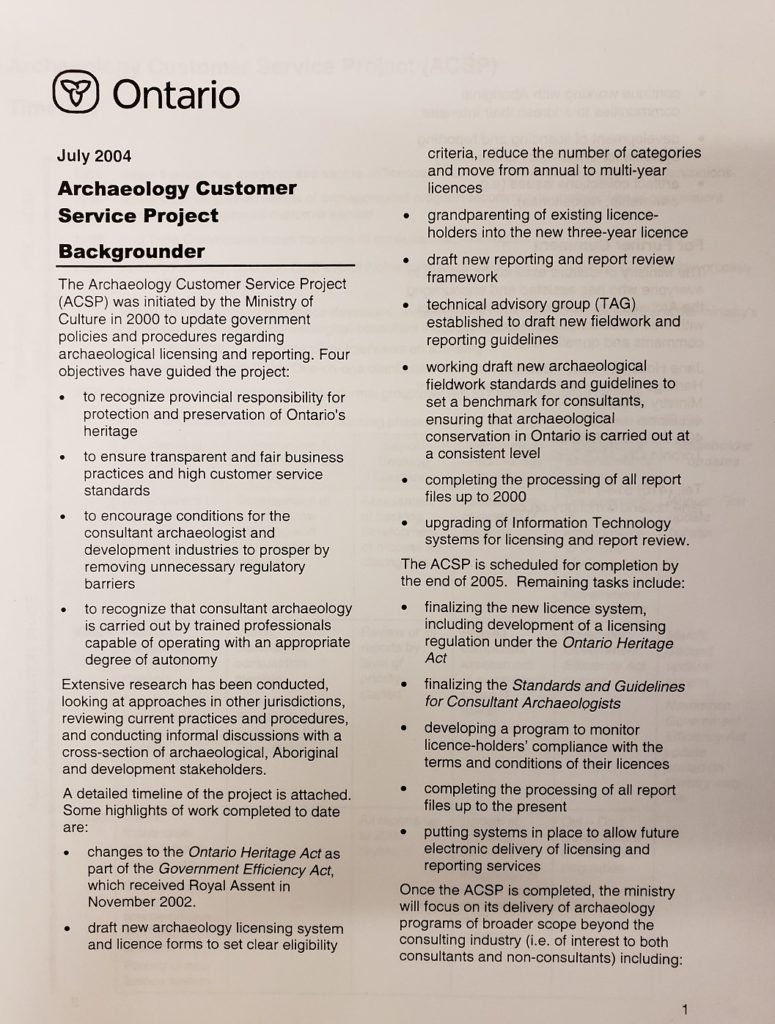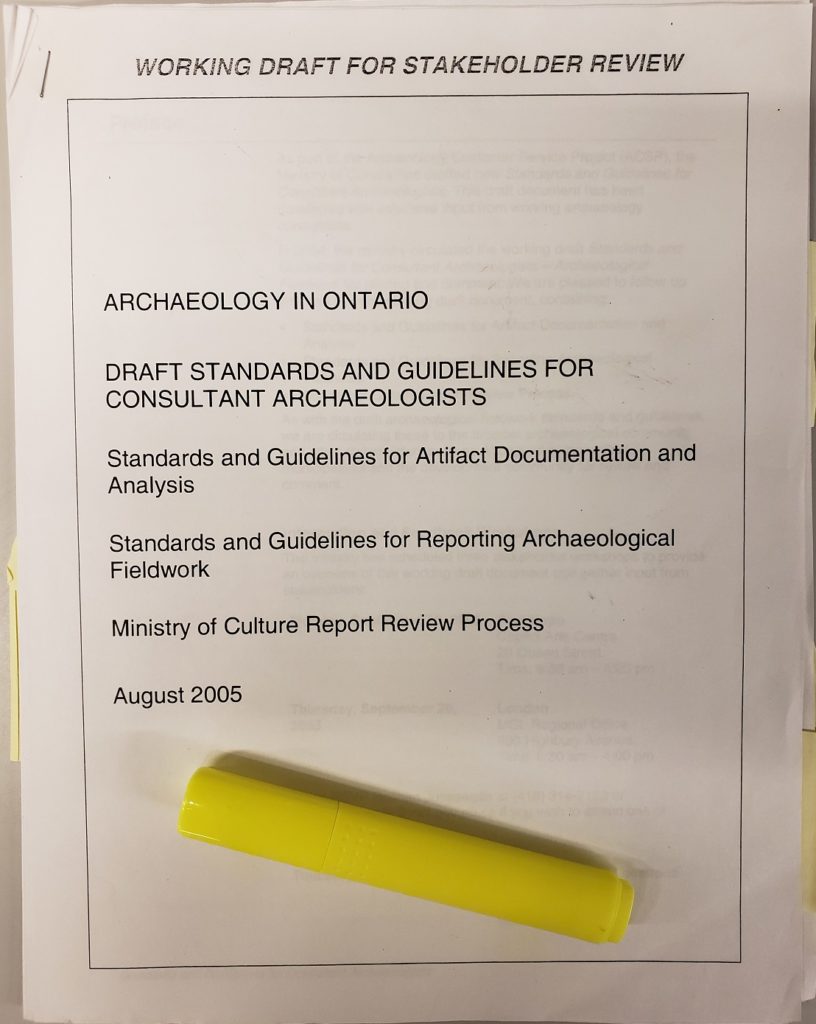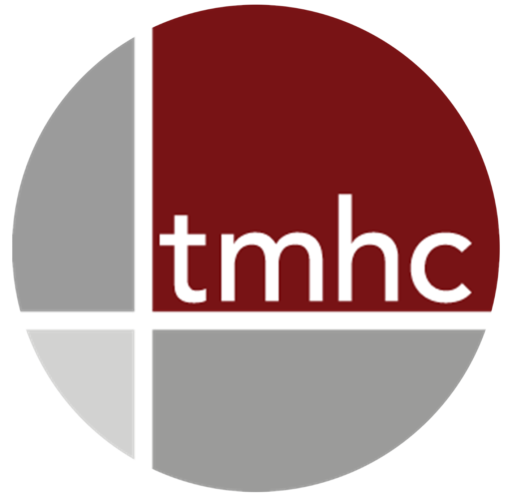Archaeology Challenged – Lessons from Twenty Years Ago

With the recent furor over Bill 66 and anticipated changes to Ontario’s Housing Supply Policy, newer archaeologists and heritage managers might think we’re living in unique and uncertain times. While perhaps uncertain, recent events resemble a similar sequence from 20 years ago. We are, in fact, re-living the past in many ways and that past turned out to be not so bad for standardizing archaeological practice in Ontario.
In 1995, the Mike Harris Progressive Conservatives (PCs) swept to power in an election that displaced Bob Rae’s New Democratic Party (NDP). Then, as now, the PCs campaigned on a platform of fiscal constraint and so-called “red tape reduction,” the reduction of bureaucracy. To that end, Mike Harris convened the Red Tape Review Commission in 1996, the report for which was released the following year. Extending previous accusations of a lack of bureaucratic transparency and personal prejudice, several commercial archaeologists and their developer counterparts filed formal complaints about the archaeology division of the Ministry of Culture with the Commission.
Contrary to their efforts, the Commission found that the processes of archaeological oversight actually reduced the potential for bureaucracy-related development delays (Ferris 2007a). Going further, the Commission found that the Ontario Heritage Act itself needed to be strengthened leading to the 2002 changes to the Act (i.e., inspectors, increased fines, etc.). The only substantive criticism from the Commission was directed at the internal inconsistency of report review. Unable to defend the absence of consistent review processes and under significant pressure from a vocal subset of the archaeological community, the Ministry initiated of the most important archaeological policy exercise in recent memory, the Archaeological Customer Service Project (the Project).

The Project began in 2000 and had four objectives:
- to recognize provincial responsibility for protection and preservation of Ontario’s heritage
- to ensure transparent and fair business practices and high customer service standards
- to encourage conditions for the consultant archaeologist and development industries to prosper by removing unnecessary regulatory barriers
- to recognize that consultant archaeology is carried out by trained professionals capable of operating with an appropriate degree of autonomy.
The Project soon recognized three parameters to these objectives:
- the archaeological community at the time was incapable of self-regulation
- archaeological conservation as a basic concept was not being challenged
- increasing Indigenous involvement had to be accounted for
With these objectives and parameters in mind, the Ministry settled on the formulation of a new prescriptive document capable of “addressing systematic deficiencies of past practices by formally articulating standards, best practices, and laying out expectations for all those involved” (Ferris 2007a: 91). Ten years later, these would become the Standards and Guidelines for Consultant Archaeologists (Standards and Guidelines). In the interim, the Ministry undertook an overhaul of the licensing system and created new licensing categories (avocational, applied research and professional).

In the end, an effort to reduce bureaucracy enabled the formulation of archaeological resource management as it is practiced in Ontario today. In thinking about contemporary times while reflecting on events of the past, archaeologists need to consider:
- How the parameters that guided the Archaeological Customer Service Project have changed in twenty years. Is archaeology now capable of self-regulation?
- Whether the trigger of the Project, inconsistent report review practices, has been resolved by the creation of Standards and Guidelines meant to govern archaeologists and reviewers alike.
- Archaeology’s integration with other planning mechanisms over the past twenty years.
- The increasing authority and heritage capacities of Indigenous communities involved in archaeology.
The fact that Mike Harris’s Red Tape Review Commission affirmed the basic premise of archaeological conservation should also not be forgotten, although that’s not to say the PCs of this era will conform to similar logics. It should instead reinforce to the current government that a similar body with similar philosophies has already expended resources and effort coming to the conclusion that archaeological heritage management is a worthwhile exercise.
References
Dent, Josh
2012 Past Tents: Temporal Themes and Patterns of Provincial Archaeological Governance in British Columbia and Ontario. Unpublished MA Thesis. Department of Anthropology, University of Western Ontario, London, Ontario.
Ferris, Neal
2007a Always Fluid: Government Policy Making and Standards of Practice in Ontario Archaeological Resource Management. In Quality Management in Archaeology, edited by W. Willems and M. van der Dries, pp. 78-99. Oxbow Books, Oxford.
2007b Fear and Loathing in Applied Archaeology, Or, Befuddled Bureaucrats & Contemptible Consultants –Lies My Career Taught Me. Paper presented at Ontario Archaeological Society Annual Meetings, Kingston, Ontario.
Mayer, Robert, G.
2000 MCzCR's archaeological customer service project: a precis. Arch Notes New Series 5(5): 5-7.
